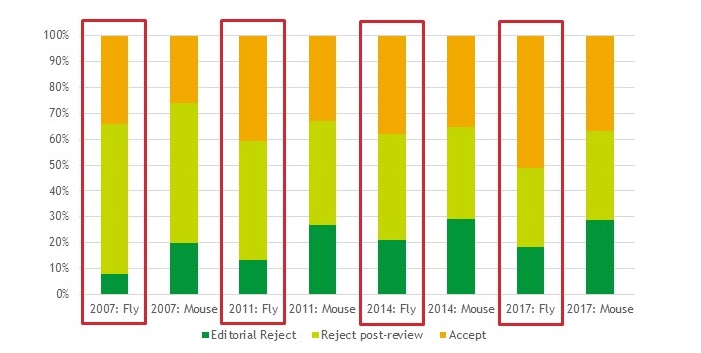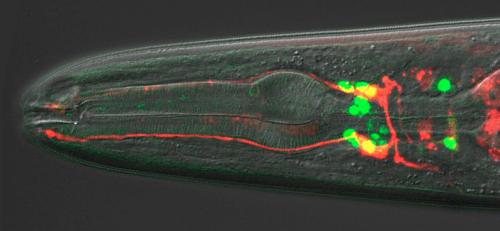Meeting report of the Cambridge Fly Club Symposium – Past, Present and Future of Drosophila Research
Posted by Jelle van den Ameele, on 10 May 2019
By Ghislain Gillard, Maria J. Gomez Lamarca, Robert Krautz, Rosa Park, David Salvador-Garcia, Yara Sanchez-Corrales and Jelle van den Ameele
On the 28th of January, the Cambridge Fly Club held its very first Symposium in the beautiful environment of Wolfson College, Cambridge, UK. This meeting, titled “Past, Present and Future of Drosophila research” was supported by a small meeting grant from the Company of Biologists and brought together 130 scientists, mostly from Cambridge, UK, who work with the fruit fly Drosophila melanogaster.
The Cambridge Fly Club is a group of PhD students and postdocs who organise a couple of scientific meetings with pizza and drinks every other month to maintain a positive dynamic within the friendly and collaborative fly community in Cambridge. However, this year, we had a special anniversary to celebrate, because 25 years ago, Andrea Brand and Norbert Perrimon published their landmark paper in Development describing the Drosophila GAL4 system (Brand and Perrimon, 1993). The GAL4 system enables targeted gene expression in virtually any cell type and has facilitated many breakthrough discoveries in physiology and developmental biology.
A modern woman’s guide to fly design
We were very lucky that Andrea Brand (WT/CRUK Gurdon Institute) agreed to give a plenary lecture about how she came to develop the GAL4 system with Norbert Perrimon. For many of the attendees, this talk was the highlight of the symposium, and for some of them even “the best talk they had ever seen”. Andrea worked on yeast transcription as a PhD student and was then a postdoctoral Fellow in Mark Ptashne’s lab at Harvard University before joining the Perrimon lab for a second postdoc. The Ptashne lab were studying the yeast transcriptional activator GAL4 and found, surprisingly at the time, that GAL4 could activate transcription in organisms other than yeast. Inspired by this knowledge and by a seminar given by Walter Gehring on his lab’s unpublished work on lacZ enhancer trapping, Andrea realized that substituting GAL4 for lacZ would enable cell fates to be manipulated in vivo, rather than merely labelled. To put theory into practice, Andrea moved to the Perrimon lab in early 1988, bringing her knowledge about yeast genetics and molecular biology together with Norbert’s expertise in Drosophila genetics. The ease of hopping the GAL4 within the Drosophila genome, through P-element transposition allowed to capture the expression pattern of new uncharacterized enhancers and resulted in large numbers of GAL4 lines being generated quickly. Andrea got her first result with the GAL4 system in September 1989 – she even showed us the page from her lab notebook!
Development of the GAL4 system was the result of hard work, dedication and resilience and even a bit of luck: Andrea was introduced to Norbert by a chance meeting with a yeast colleague, Fred Winston. Andrea gave a great and positive message for all young scientists in the audience and inspired us with some of her creative poster designs – “a modern woman’s guide to fly design” did stick in our minds! Her message was to follow your dreams in spite of the inevitable hurdles that come your way.
Collaborative workshops
The plenary lecture was then followed by several high-quality workshops, delivered by leaders in their respective fields and mostly focused on transformative technologies from the past, present and future.
The different aspects of CRISPR/Cas9 in flies were nicely introduced in a very popular workshop by Simon Bullock from the MRC Laboratory of Molecular Biology. He talked about how to use CRISPR-Cas9 to generate mutant alleles, tag proteins and even perfom tissue-specific gene disruption. His talk was full of practical tips and advice, including potential pitfalls and how to recover the desired mutation. In a workshop on the art and history of genetic screens, Daniel St Johnston from the WT/CRUK Gurdon Institute presented an impressive overview of the various strategies to perform forward genetic screening, illustrating every approach with a historical landmark paper. Which mutagen to go for – EMS according to Daniel, or X-rays (without the protective plastic cover) according to Adelaide Carpenter – remains an unsolved question though.
Three other workshops were set up as collaborations between scientists from different institutes across Cambridge. Ben Sutcliffe (MRC Laboratory of Molecular Biology), Edward Allgeyer and George Sirinakis (WT/CRUK Gurdon Institute) gave an overview of imaging Drosophila tissues using three different advanced light microscopy techniques: single molecule localization microscopy, STED, and light-sheet microscopy. Considering the notorious difficulty of applying super-resolution methods to thick biological samples, Ed and George generated a lot of interest into how they custom-built 4Pi-SMS and STED microscopes for imaging different Drosophila tissues such as the ovary. Equally exciting was Ben’s imaging setup for capturing live tissue-dynamics of Drosophila embryos and larval salivary glands on a custom-built light-sheet microscope.
Alex Whitworth (MRC Mitochondrial Biology Unit), Cahir O’Kane (Department of Genetics) and Hansong Ma (WT/CRUK Gurdon Institute) convinced us that there is now a critical mass in Cambridge to study mitochondria in fruit flies. They introduced us to impressive and creative usage of powerful fly genetics to study mitochondrial inheritance and explained some exciting new discoveries with direct implications for neurodegenerative diseases. Finally, Greg Jefferis (MRC Laboratory of Molecular Biology), Matthias Landgraf and Marta Costa (Department of Zoology) teamed up to show that today’s high-level connectivity between Drosophila researchers had striking parallels in the Drosophila brain, whose neuronal networks they study with state-of-the-art techniques and powerful computational algorithms.
All the data, interpretations and scientific excitement that come from these technologies have to be shared of course. One platform that is widely used by the fly community is FlyBase, and Steven Marygold provided a very practical overview of how to perform large-scale queries in FlyBase. However, we all still like to publish our findings as a story, in the form of a journal article. Katherine Brown from Development, therefore, provided us with some very useful tips to make this actually happen – even the fly paper she published herself in Development 16 years ago turned out to offer room for improvement! She also generated new data for this symposium, summarising the success of Drosophila papers as opposed to other model organisms. These are more thoroughly discussed in her own recent blogpost.
A bright future for Drosophila research?!
To end this wonderful afternoon, Michael Akam, Andrea Brand, Cahir O’Kane, Katja Röper, Benedicte Sanson and Daniel St Johnston wholeheartedly joined in the game of discussing the future of Drosophila research. Young researchers clearly heard that it is not the model that makes great research, but the questions you ask. The powerful genetics, the possibility to study cell biology within a living organism, the emerging tools to study behaviour, or the relatively cheap maintenance of flies are only several of the many reasons why Drosophila will remain an important research model in the future. One reason to work with Drosophila was not discussed by the panel though: it makes you part of a wonderful, generous and vibrant community. Today’s symposium was a warm celebration of this great community.

This meeting has been organised thanks to the kind support of the Company of Biologists with several other sponsors which can be found together with the program of the event here.


 (2 votes)
(2 votes)



 (No Ratings Yet)
(No Ratings Yet) The first human genome sequence cost billions of dollars. Today, we’ve broken through the thousand dollar barrier and are heading towards $100.
The first human genome sequence cost billions of dollars. Today, we’ve broken through the thousand dollar barrier and are heading towards $100. 


